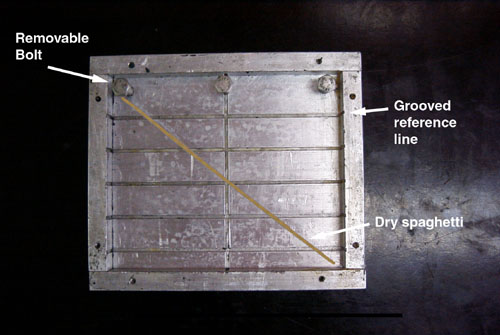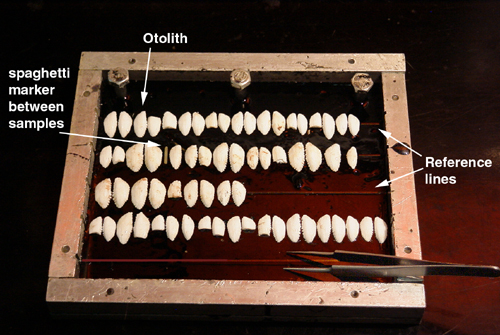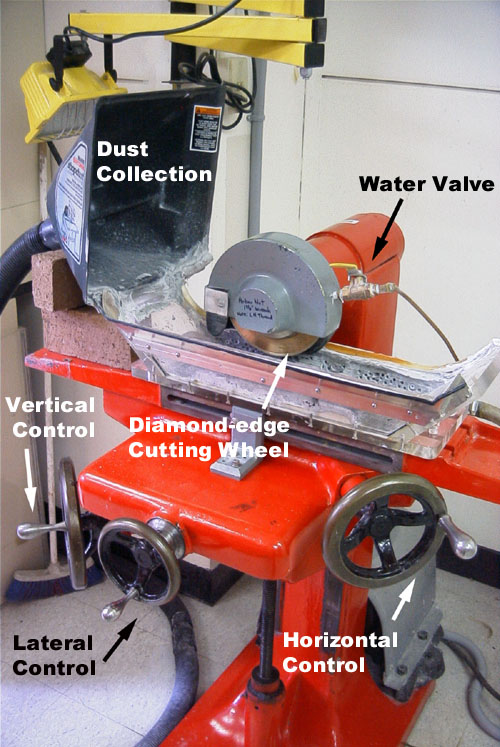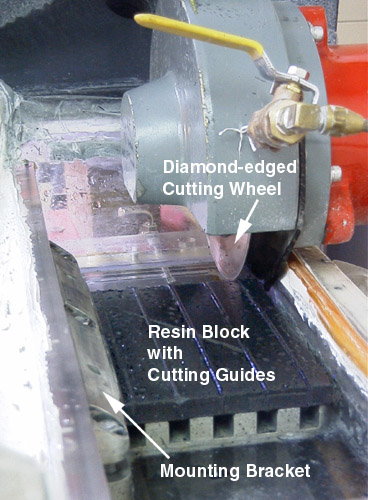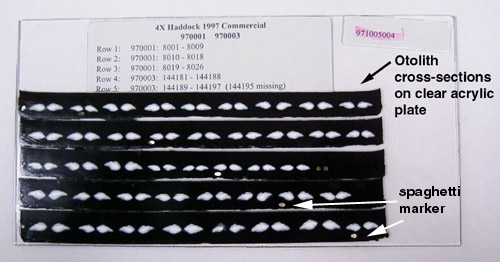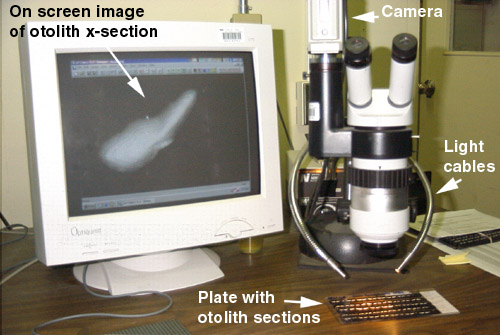Production Ageing
Age determination is an important component of fish stock assessments. In our laboratory, tens of thousands of otoliths are sectioned and aged each year in support of stock assessments. We use production methods which involve embedding 50-100 otoliths in a polyester resin block, sectioning with a high-speed saw to produce transverse thin sections, coating with a photographic clear coat to enhance visibility, and ageing under an image analysis system. Using these methods, it is possible for one person to prepare on the order of 300-800 otoliths per day, or to age about 200 per day. Note that these methods are most appropriate for robust otoliths at least 1 cm in length; smaller or more fragile otoliths are best embedded in epoxy and sectioned individually with an Isomet saw, a process which is much more time-consuming.
We have prepared a 15-minute VIDEO DEMONSTRATION of production methods for embedding and sectioning otoliths embedded in polyester resin blocks, which provides an easy and complete overview of the process. The information below also describes the steps and materials used in mass producing and mounting transverse sections, but provides more detail on some of the materials and suppliers than does the video.
Embedding:
Aluminium trays (177 x 154 x 18 mm, outside dimensions) are used as moulds. The trays have grooved bottoms and sides to produce cutting guides; removable sides to assist in the release of the hardened resin block; and removable bolts which serve to make holes for the insertion of the positioning posts on the saw. To release the block from the mould and to prevent leakage of resin a thin layer of household paste wax is applied to the inside of the tray to seal all seams. To ensure correct sequencing of sections a piece of dry spaghetti is placed diagonally across the tray from upper left to lower right corners.
Clear casting resin (23189), pigmented black with 100 ml pigment: 4 litres of resin, and catalysed with the hardener Luperox DDM-9 BT300 to gel in 30 minutes is used as the embedding medium. All procedures involving the resin are carried out in a fume hood and any resin spills are removed with acetone. A layer of resin mixture is poured into the trays to cover the spaghetti strand and fill the corners.
Once the resin has set reference lines can be etched into the resin, using the grooved lines on the tray as guides. Otoliths are arranged with the core of the otolith positioned on the reference line. Taking care not to disturb the alignment of the otoliths, trays are filled with resin and left to cure for a minimum of 24 hours prior to sectioning. 100 to 150 otoliths (depending on size) may be placed in one tray.
Sectioning:
A surface grinder was adapted to accommodate a diamond-edged cutting wheel (UPC # 66260257622, shape 1AIR, 7 x .025 x 1 1/4) and modified to include a mounting bracket and cutting base for the resin block, a water outlet to provide cooling and lubrication to the cutting wheel, and a splash tray with water drainage.
Blocks (approximately 10 mm thick) are removed from the moulds, mounted in the saw on the positioning posts, and secured with the mounting bracket. Using the vertical, horizontal and lateral controls the edge of one of the block's cutting guides is positioned so it is in alignment with the saw's cutting wheel. Sections (1 mm thick) are removed, rinsed with water, and air-dried. Sections to 0.5 mm thickness can be produced without breakage.
Care is taken to ensure that individual otoliths, or otolith pairs, can be identified throughout the embedding and sectioning procedures. A soft pencil can be used to write otolith numbers on the cut resin strips, directly under the otolith.
Strips of sectioned otoliths and appropriate labels are mounted onto sheets of clear acrylic (185 x 95 x 2mm) with transparent spray coating (Krylon Crystal Clear 41303). After the plates have dried a topcoat of spray is applied to both protect the sections and enhance their clarity. The Krylon coating tends to hide scratches and grooves in the cut surface of the otolith.
Ageing:
Once the plates have dried otolith sections are aged using an Image Analysis System with reflected light and a magnification of 10 to 12x.
Otoliths prepared in this manner provide an efficient and cost effective means for ageing and storing large numbers of samples. Since the otolith plates are dry, they can be stored compactly (eg- vertically in filing cabinets) with an indefinite shelf life.
